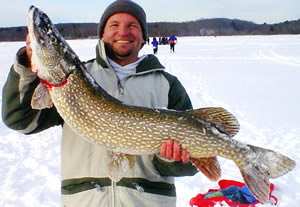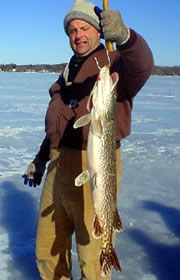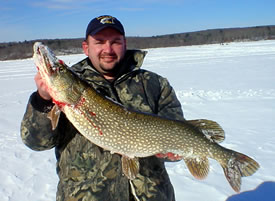Ice Fishing Jersey PikeContracting Biologist December, 2005
Northern
pike are easily caught throughout the winter months, and ice fishing is one of
the best ways to target them. I can expect to catch anywhere from 1 to a dozen
in a day's time on a lake that harbors them. The secret is the right equipment,
location and bait presentation.
Getting
On the Ice
My ice-fishing excursions begin with checking the ice for thickness. However,
anyone who goes out onto a frozen body of water must realize that there is usually
a degree of risk and needs to be aware of conditions. Ice seldom freezes at a
uniform rate, and what constitutes a safe ice is difficult to apply in all cases.
While three inches of ice on a farm pond may pose little danger, that
same three inches on a moving stream or lake with springs, stumps and currents
could be very dangerous. Massachusetts Wildlife has a handy chart to determine
safe ice conditions at www.mass.gov/dfwele/dfw/dfwice.htm.
I
usually do not venture out unless the ice is at least 4 inches thick for safety reasons
and to keep myself alive and dry - I recommend you do the
same. It's relatively easy to check the thickness: take your auger or spud (basically
a very long-handled chisel for chopping a hole in the ice) and drill about 6 feet
away from the shoreline. Depending on the thickness, you can make the determination
of whether to proceed or move to another location
Equipment
I've
found that tip-ups are the best tool for catching pike since it's mostly a waiting
game. Some anglers do use jigs and other lures, but I always suggest that beginners,
or even experienced ice anglers, stick to tip-ups. New Jersey allows a maximum
of 5 tip-ups per person and they can be purchased in bait and tackle stores
or ordered through a catalog or online.
I
prefer large wooden tip-ups for their strength and durability, spooled with 40
pounds of black dacron line. The thicker dacron line is easier to pull up when
you've hooked a fish, and it keeps you from cutting your hands. Pike are not hook
shy, so use a leader on a size 2 or 4 hook. I like to add a rattler about a foot
above the hook to draw in the fish. Rattlers are normally used for rubber worms,
but some have a hole through them to attach a line. An auger that can drill an 8-inch hole is needed because some pike may be
in excess of 15 pounds - hook into one of them and you will regret buying a 4
or 6-inch borer when you can't bring up the fish. The extra inches are worth the
investment. Augers are available in gas or hand powered, and both work equally
well. Each type, of course, has advantages and disadvantages. To haul equipment across the ice, a sled comes in handy. Some anglers build
elaborate sleds, or modify a sled they own, but a simple kid's sled works wonders
and costs only a few dollars. Location,
Location, Location!
I know the feeling of walking out onto a lake all pumped up to catch fish and,
seeing the vast expanse of "Frozen Tundra" ahead of me, thinking, "where
should I begin?". So let's take the guesswork out of it. Simply look for
any protruding points and start trekking towards that point. Northern pike like
to hang near points, and it also acts as a funneling spot for traveling pike.
Start drilling about 15 feet from the tip of the point. Check the depth and
if it's deeper than 3 feet, set your first tip-up. Deploy the rest of your tip-up
in 20 to 40 foot increments angling away from the point and checking the depth
in each one. I use a clip-on weight (looks like a bank sinker with clamps) to
determine the water depth. Once your rig (no bait yet) hits bottom, pull the line
up a couple feet then attach a marker (split shot) on the part of the line level
with the water. This gives you a pre-set marker so you do not have to do this
every time you check your bait. Make sure to take the clip-on weight off before
you bait at this point.
Bait can be hard to find during the winter, however you can catch and store your own bait. Yellow and white perch are easy to catch and can be stored for an extended period of time in an aerated live well. I've kept perch in a garbage can with an aerator for a month at a time without any problems except for their by-products. Native perch tend to swim more on a hook and go berserk when a predator swims near it. Hook your bait through the body at the base of the dorsal fin and use a split shot above the leader to help bring down the bait. I usually start at the first tip-up and bait as I go to the last one. Check the bait every 15 minutes, and at the same time clear the ice forming in the hole. If your bait appears to be lively then drop it back down, if not then put a new bait on. Tip-Up! When your flag goes up indicating a fish has taken your bait, take your time and slowly walk over - most people make the mistake of running to the tip-up sounding like an elephant and scaring away the fish. Just gently raise the tip-up out of the hole and get control of the line while letting it continue to spool out freely. Then set the hook. The line is strong enough to pull the pike out of the water. I would not spend more than 3 hours at a given location if the spot isn't producing. When that happens, just pack up and look for another point and head over there. This winter, don't sit around the house wishing for spring. Get the gear ready and head out to a frozen lake to catch Jersey Pikes. Remember to release those you do not plan to keep as quickly as possible to ensure that the success of this fishery continues. If you catch a whopper, feel free to call us at the Lebanon Fisheries Office at 908-236-2118. ADDITIONAL PAGES
|
|||||||||||||||||||
|
||
|
|
||
|
||
| |
||



